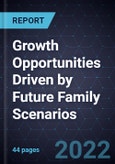Aging population, urbanization, and decreasing fertility rates have ushered major shifts in family structures the world over. More people are choosing to live in cost-effective, easily available, single-occupancy units in highly urbanized areas. With more women entering the labor force, government policies and strategies are focusing on gender-equal pay. Legislation for equal status for the LGBTQ community is leading to new dimensions in family structure. With economic independence, more and more women are opting to stay single and childless for longer periods of time. New career opportunities and work-related goals, and gender economic equality challenge the traditional family structure.New Family Structures and Consumption Patterns Leading to New Business Growth Strategies
This comprehensive study covers evolving family structures, explores major future trends, and highlights opportunities arising from such changes. Over the next decade, we will see an 8-10% increase in single-person and single-parent households. About 30% of couple-only households will remain childless by 2030, and developed countries will see double-digit growth in rainbow families during the same timeframe. As the family structure shrinks from a unit of 4 members to just a single person, technology will play a significant role in not only making a household but also in fulfilling the functional role of a companion. From robotic caregivers to virtual companions, AI-enabled robots will be an integral part of future families. Free time and financial requirements will change and generate many business opportunities for companies.
Key Issues Addressed
- How will the family structure change in the upcoming years?
- What are the prominent family structure types that will be formed worldwide?
- What will be the consumption patterns of each of these new family structures?
- How can companies generate opportunities from these changing family structures and expand their offerings?
- What are the critical success factors for companies seeking to cater to this trend?
Table of Contents
1. Strategic Imperative
2. Growth Environment
3. Trend Opportunity Analysis
4. Growth Opportunity Universe
5. Next Steps








